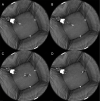Turning preference in dogs: North attracts while south repels
- PMID: 33507979
- PMCID: PMC7842976
- DOI: 10.1371/journal.pone.0245940
Turning preference in dogs: North attracts while south repels
Abstract
It was shown earlier that dogs, when selecting between two dishes with snacks placed in front of them, left and right, prefer to turn either clockwise or counterclockwise or randomly in either direction. This preference (or non-preference) is individually consistent in all trials but it is biased in favor of north if they choose between dishes positioned north and east or north and west, a phenomenon denoted as "pull of the north". Here, we replicated these experiments indoors, in magnetic coils, under natural magnetic field and under magnetic field shifted 90° clockwise. We demonstrate that "pull of the north" was present also in an environment without any outdoor cues and that the magnetic (and not topographic) north exerted the effect. The detailed analysis shows that the phenomenon involves also "repulsion of the south". The clockwise turning preference in the right-preferring dogs is more pronounced in the S-W combination, while the counterclockwise turning preference in the left-preferring dogs is pronounced in the S-E combination. In this way, south-placed dishes are less frequently chosen than would be expected, while the north-placed dishes are apparently more preferred. Turning preference did not correlate with the motoric paw laterality (Kong test). Given that the choice of a dish is visually guided, we postulate that the turning preference was determined by the dominant eye, so that a dominant right eye resulted in clockwise, and a dominant left eye in counterclockwise turning. Assuming further that magnetoreception in canines is based on the radical-pair mechanism, a "conflict of interests" may be expected, if the dominant eye guides turning away from north, yet the contralateral eye "sees the north", which generally acts attractive, provoking body alignment along the north-south axis.
Conflict of interest statement
No authors have competing interests.
Figures




Similar articles
-
Directional preference in dogs: Laterality and "pull of the north".PLoS One. 2017 Sep 25;12(9):e0185243. doi: 10.1371/journal.pone.0185243. eCollection 2017. PLoS One. 2017. PMID: 28945773 Free PMC article.
-
A magnetic compass guides the direction of foraging in a bat.J Comp Physiol A Neuroethol Sens Neural Behav Physiol. 2019 Aug;205(4):619-627. doi: 10.1007/s00359-019-01353-1. Epub 2019 Jun 21. J Comp Physiol A Neuroethol Sens Neural Behav Physiol. 2019. PMID: 31227860
-
Shifted magnetic alignment in vertebrates: Evidence for neural lateralization?J Theor Biol. 2016 Jun 21;399:141-7. doi: 10.1016/j.jtbi.2016.03.040. Epub 2016 Apr 6. J Theor Biol. 2016. PMID: 27059891
-
Calibration of magnetic and celestial compass cues in migratory birds--a review of cue-conflict experiments.J Exp Biol. 2006 Jan;209(Pt 1):2-17. doi: 10.1242/jeb.01960. J Exp Biol. 2006. PMID: 16354773 Review.
-
Identifying Cellular and Molecular Mechanisms for Magnetosensation.Annu Rev Neurosci. 2017 Jul 25;40:231-250. doi: 10.1146/annurev-neuro-072116-031312. Annu Rev Neurosci. 2017. PMID: 28772099 Free PMC article. Review.
Cited by
-
Visual perception of emotion cues in dogs: a critical review of methodologies.Anim Cogn. 2023 Jun;26(3):727-754. doi: 10.1007/s10071-023-01762-5. Epub 2023 Mar 4. Anim Cogn. 2023. PMID: 36870003 Free PMC article. Review.
-
Neuropsychological Evidence Underlying Counterclockwise Bias in Running: Electroencephalography and Functional Magnetic Resonance Imaging Studies of Motor Imagery.Behav Sci (Basel). 2023 Feb 15;13(2):173. doi: 10.3390/bs13020173. Behav Sci (Basel). 2023. PMID: 36829402 Free PMC article.
References
-
- Yosef R, Raz M, Ben-Baruch N, Shmueli L, Kosicki JZ, Fratczak M, et al., Directional preferences of dogs’ changes in the presence of a bar magnet: Educational experiments in Israel. J Vet Behav. 2020; 35: 34e37 10.1016/j.jveb.2019.10.003. - DOI
Publication types
MeSH terms
LinkOut - more resources
Full Text Sources
Other Literature Sources

